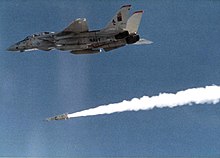This is an old revision of this page, as edited by TheRandomResearcher (talk | contribs) at 14:02, 29 December 2024. The present address (URL) is a permanent link to this revision, which may differ significantly from the current revision.
Revision as of 14:02, 29 December 2024 by TheRandomResearcher (talk | contribs)(diff) ← Previous revision | Latest revision (diff) | Newer revision → (diff)
Lofting is a trajectory optimization technique used in some missile systems to extend range and improve target engagement effectiveness, usually in Beyond-Visual Range Scenarios.

Method
Lofting involves a missile ascending to a higher altitude after launch, creating a parabolic arc similar to Ballistic Missiles, before descending toward its target. This elevated flight path allows the missile to capitalize on reduced air resistance at higher altitudes, increasing both the missile's potential energy and the kinetic energy during terminal guidance, thus enabling greater range and Probability of kill.
Lofting typically occurs at altitudes ranging from 20,000 to 50,000ft, but can range up to 400km when used as a ballistic trajectory.
Advantages
Lofting offers several distinct advantages compared to sea-skimming and direct-intercept trajectories, particularly in beyond-visual-range engagements.
Unlike sea-skimming, which prioritizes low-altitude flight to avoid radar detection but suffers from increased drag and limited range, lofting allows the missile to ascend to higher altitudes where air resistance is lower. This reduced drag enables greater range and energy efficiency, allowing the missile to retain more kinetic energy for terminal guidance and target interception.
Compared to direct-intercept trajectories, lofting also improves engagement flexibility by providing a steeper attack angle, which is particularly effective against maneuvering or high-altitude targets.
Disadvantages
In comparison to sea-skimming trajectories, lofting lacks radar-avoidance characteristics, making it susceptible to detection by its target and potential interceptors.
Lofting is also more mathematically and technologically complex in comparison to direct-interception, and is only viable in long-range engagements.
Additionally, the thinner air which lofting utilizes to reduce drag and increase range carries the downside of impeding the ability for control surfaces to maneuver the missile. This can reduce a missile's ability to adjust for fast-moving or maneuvering targets, however can be circumvented with the use of thrust vectoring - at the downside of added cost and complexity.
Use in Missiles
A number of missiles are known or speculated to utilize lofting techniques, such as:
- AIM-120 AMRAAM - United States
- AIM-54 Pheonix - United States
- AIM-260 JATM - United States
- Meteor - France, Sweden, United Kingdom, Germany
- R-77 - Russia
- PL-15 - China
See also
References
- ^ Shin1, Tahk2, Kim3, Lee4,, Minjae1, Min-Jea2, Boseok3, Chang-Hun4, (2024). "PURSUIT-BASED LONG-RANGE AIR-TO-AIR MISSILE MIDCOURSE GUIDANCE ROBUST TO CHANGES IN THE PREDICTED IMPACT POINT" (PDF). International Congress of the Aeronautical Sciences.
{{cite journal}}: CS1 maint: extra punctuation (link) CS1 maint: multiple names: authors list (link) CS1 maint: numeric names: authors list (link) - ^ AIM-120C-5 Performance Assessment for Digital Combat Simulation Enhancement Revision 2 September 2014 Thomas Tyrell, United Kingdom Christian Funk, United States of America Nagy Marton, Hungary
- ^ Karon (2019-08-29). "AIM-54 and AWG-9 WCS: Observations about Lofted Trajectory and Range". FlyAndWire. Retrieved 2024-12-25.
- "Wayback Machine" (PDF). www.koreascience.or.kr. Archived from the original (PDF) on 2024-09-04. Retrieved 2024-12-29.